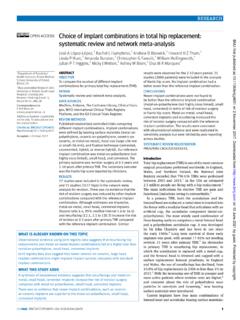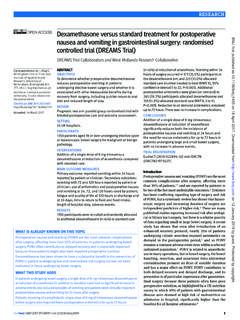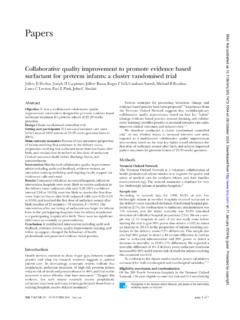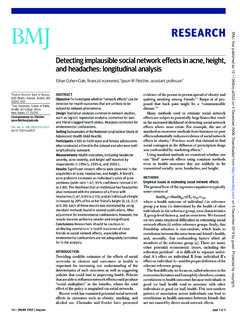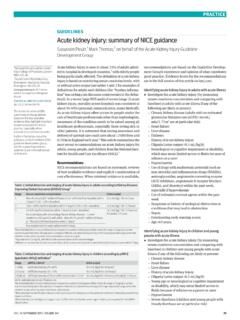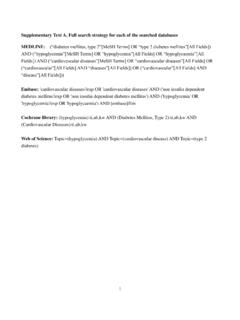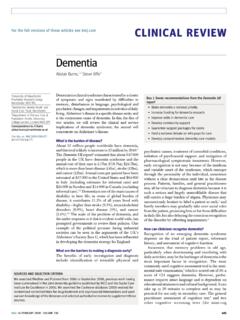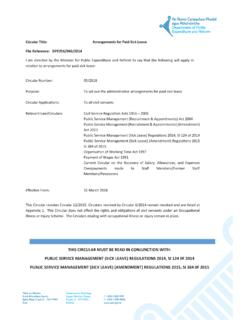Transcription of Understanding organisational culture for healthcare ...
1 QUALITY IMPROVEMENTU nderstanding organisational culture for healthcarequality improvement OPEN ACCESSR ussell Mannion and Huw Davies explore how notions of culture relate to service performance,quality, safety, and improvementRussell Mannion professor 1, Huw Davies professor 21 Health Services Management Centre, University of Birmingham, Birmingham, UK; 2 School of Management, University of St Andrews, St Andrews,UKKey messagesOrganisational culture represents the shared ways of thinking, feeling,and behaving in healthcare organisations are best viewed as comprising multiplesubcultures, which may be driving forces for change or may underminequality improvement initiativesA growing body of evidence links cultures and quality, but we need a morenuanced and sophisticated understandings of cultural dynamicsAlthough culture is often identified as the primary culprit in healthcarescandals, with cultural reform required to remedy failings, such simplisticdiagnoses and prescriptions lack depth and specificityIf we believe the headlines, health services are sufferingepidemics of cultural shortcomings.
2 Extensive enquiries intofailures and scandals in the NHS over several decades haveindicated aspects of hospital culture as leading to thosefailings.(box 1).1 2 The recent report into over 450 prematuredeaths at Gosport War Memorial Hospital mentions culture After such reports, widespread and fundamental culturalchange is typically prescribed as the remedy (box 1).4 5 Box 1: Centrality of culture to healthcare scandals: fromKennedy to FrancisFrom Ian Kennedy s review of the failings in paediatric cardiac surgery inBristol during the 1980s and 90s2 to Robert Francis s inquiry into the systemicfailings at Mid Staffordshire Hospital Trust over a decade later,1 culture hasbeen as culprit There was an insular club culture [at Bristol], in which it was difficult foranyone to stand out, to press for change, or to raise questions and concerns (p302)2 Aspects of a negative culture have emerged at all levels of the NHS include: a lack of consideration of risks to patients, defensiveness,looking inwards not outwards, secrecy, misplaced assumptions of trust,acceptance of poor standards, and, above all, a failure to put the patient firstin everything done (p2357)1 culture as remedy The culture of healthcare , which so critically affects all other aspects of theservice which patients receive, must develop and change (p277)2 The extent of the failure of the system shown in this inquiry s report suggeststhat a fundamental culture change is needed (p65)1 Ideas of culture are also central to quality improvement basic clinical audit to sustained improvement collaboratives, business process re-engineering, Lean SixSigma, the need for cultural reorientation is part of Yet although the language of organisationalculture sometimes culprit, sometimes remedy, and alwayspart of the underlying substrate at which change is directed hassome immediate appeal, we should ask deeper questions.
3 Whatactually is culture in health services? How does culture relateto healthcare quality, safety, and performance? And canchanging culture lead to improvements in care and organisationalperformance?Correspondence to: R Mannion commercial reuse: See rights and reprints : 2018;363:k4907 doi: (Published 28 November 2018)Page 1 of 4 AnalysisANALYSIS on 8 May 2022 by guest. Protected by : first published as on 28 November 2018. Downloaded from Greater specificity around both culture and performance enablesus to understand more precisely the possible relations betweenthem: quality improvement work is ill served by broadbrushaccounts of culture and service quality. We seek to move pastthe use of culture as simply a rhetorical tool used by politiciansand in policy edicts. Instead, we outline a more nuanced accountof the social dynamics of healthcare is culture in this context? healthcare organisational culture (from here, just culture ) is ametaphor for some of the softer, less visible, aspects of healthservice organisations and how these become manifest in patternsof care.
4 The study of organisational practices derives from socialanthropologists approaches to the study of indigenous people:both seek to unravel the dynamics of unfamiliar tribes. Theview that culture can be managed to remedy past deficits andproduce desirable future outcomes is often smuggled in throughthis re-application of the ideas of culture to organisations. Thisview needs some critical scrutiny,5 one that explores a morenuanced account of organisational culture in one common framing,7 the shared aspects of organisationallife the culture are categorised as three (increasinglyobscured) layers (box 2). First, and most visible, are the physicalartefacts and arrangements, as well as the associated behavioursthat get things done. These visible manifestations of culture areseen in how estate, equipment, and staff are configured andused, and in the range of behaviours seen as normal andacceptable. These include the embedded and accepted carepathways, clinical practices, and communication patterns,sometimes referred to as the way things are done around here.
5 Box 2: Three levels of organisational culture in healthcare7 8 Visible manifestations of healthcare culture include the distribution of servicesand roles between service organisations (such as the long established dividesbetween secondary and primary care and between health and social care),the physical layouts of facilities (receptionists behind desks and doctors inconsulting rooms), the established pathways through care (including theubiquitous outpatients appointment), demarcation between staff groups inactivities performed (and the tussles that challenge or reinforce these), staffingpractices and reporting arrangements, dress codes (such as different colouredscrubs for different staff groups in emergency departments), reward systems(pay and pensions, but also the less tangible rewards of autonomy andrespect), and the local rituals and ceremonies that support approved manifestations of culture (sometimes called artefacts) also include theestablished ways (both formal and informal) of tackling quality improvementand patient safety, the management of risk, and the accepted ways ofresponding to staff concerns and patient feedback or ways of thinking include the values and beliefs used to justify andsustain the visible manifestations above and their associated behaviours, aswell as the rationales put forward for doing things differently.
6 This might includeprevailing views on patient needs, autonomy, and dignity; ideas about evidencefor action; and expectations about safety, quality, clinical performance, andservice shared assumptions are the (largely unconscious and unexamined)underpinnings of day-to-day practice. These might include ideas aboutappropriate professional roles and delineations; expectations about patients and carers knowledge and dispositions; and assumptions about the relativepower of healthcare professionals collectively and individually in the second level is the shared ways of thinking that are used tojustify the visible manifestations (box 2). This includes thebeliefs, values, and arguments used to sustain current patternsof clinical practice. In this way, the local clinical culture isexpressed not only through what is done, but also how it istalked about and still, and thus much less overt and accessible, are thelargely unspoken and often unconscious expectations andpresuppositions that underpin both dialogue and clinical practice(the shared assumptions; box 2).
7 Such attitudes may be formedearly, go deep, and be less amenable to three levels are linked, of course, but not simply. Someof the deeper values and assumptions are taught in earlyprofessional education (the so-called hidden curriculum),reinforced through ongoing professional interactions, and thenmade visible as accepted practices. Other cultural manifestationsare created or shaped externally, perhaps by the macro policyenvironment (for example, service configurations or rewardsystems), but over time these can influence shared ways ofthinking and even deeper assumptions (about who or what isvalued, for example). As healthcare becomes more global, withregular movement of care staff across national borders, majorshapers of the cultural aspects of care may also include national,ethnic, or religious culture , then, covers how things are arrangedand accomplished, as well as how they are talked about andjustified that is, the stories and narratives about what is doneand why, and the presuppositions that underpin these.
8 Takentogether these can reflect a shared and commonly understoodview of hospital life manifested in patterns of care, safety, andrisk. Although we focus on the hospital environment here, thesearrangements and narratives are found (albeit in different forms)across all healthcare organisations from general practices tocommunity trusts. Those wishing and situated to improveservices need a sophisticated Understanding of the socialdynamics and shared mental schema that underpin and reinforceexisting practices and inform their readiness to important additional layer of complexity is that sharedmental schema may be confined to subgroups within careservices, with important implications for patient experience andservice culture or many subcultures? healthcare organisations are notoriously varied, fractured byspecialty, occupational groupings, professional hierarchies, andservice lines. Some cultural attributes might be widespread andstable, whereas others may be shared only in subgroups or heldonly tentatively.
9 Important subcultures are delineated mostobviously, as professional groups, and the faultlines are mostobvious as these groups compete for resources and Othersubcultures can emerge over time. Some staff groupings mayexcel at articulating and enacting desirable values and practices,which may be helpful to organisational goals; for example,specialist teams or centres of excellence. Less helpfully perhaps,other subgroups may actively work to undermine changespromoted from external sources (often construed ascountercultures). Whether such countercultures reflectunwarranted resistance to change or a more appropriate defenceof enduring values may be hard to discern and depends on bothperspective and , then, are a dynamic cultural mosaic made up ofmultiple, complex, and overlapping subgroups with variablyshared assumptions, values, beliefs, and behaviours. Two of themajor professional groupings concerned with qualityimprovement doctors and managers may differ in severalimportant ways, for example.
10 Doctors may focus on patients asindividuals rather than groups and view evidence through apositivist natural sciences lens. Managers may be moreconcerned with patients as groups and value a social sciencebased experiential These cultural divergenceshave important implications for collaborative work, especiallyfor people in hybrid roles who may either retain a culturalallegiance to their base group or seek to adopt the culturalorientations of their new role. They also form an importanttarget for purposeful cultural reform, which might sometimesNo commercial reuse: See rights and reprints : 2018;363:k4907 doi: (Published 28 November 2018)Page 2 of 4 ANALYSIS on 8 May 2022 by guest. Protected by : first published as on 28 November 2018. Downloaded from seek to strengthen current trends or at other times to sum, specific subcultures may be powerful catalysts forinnovation and improvement or defenders of the status quo (forgood or ill); they can be useful safeguards against risk or covertcountercultures quietly undermining necessary reforms.


